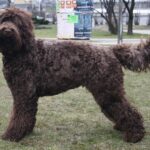
Introduction
Dog breeds play a significant role in our lives, offering companionship, protection, and various forms of assistance. Each breed has its unique characteristics and traits, making them suited for different lifestyles and needs. Among these breeds, the Bullmastiff stands out as a remarkable companion known for its loyalty and protective nature. This article aims to provide a comprehensive overview of the Bullmastiff, including its history, physical characteristics, temperament, care requirements, and overall suitability as a family pet.
Overview of the Bullmastiff
History and Origin
The Bullmastiff originated in the United Kingdom during the 19th century, developed primarily as a guard dog. Its creation was a response to the need for a breed that could protect estates and property from poachers. The Bullmastiff is a mix of the Mastiff and Bulldog, combining the strength and size of the former with the agility and tenacity of the latter. This unique blend resulted in a powerful, alert, and devoted breed capable of guarding vast areas while being gentle with families.
Physical Characteristics
Bullmastiffs are large, robust dogs, with males typically weighing between 110 to 130 pounds and females ranging from 100 to 120 pounds. Their height usually falls between 24 to 27 inches at the shoulder, giving them a commanding presence.
In terms of coat, Bullmastiffs sport a short, dense layer that is easy to maintain. They come in various colors, including fawn, brindle, and red. One of their most distinctive features is their broad head, which is proportionate to their body, giving them a noble and imposing appearance. Their powerful build and muscular structure contribute to their reputation as excellent guard dogs.
Temperament and Behavior
The temperament of the Bullmastiff is a blend of loyalty, protectiveness, and gentleness. They are known to be extremely devoted to their families, often forming strong bonds with children and other pets. Despite their intimidating size, Bullmastiffs are generally gentle and patient, making them suitable for households with kids.
However, they have a natural guarding instinct, which means early socialization is crucial. Properly socialized Bullmastiffs are friendly with strangers and other animals. Without proper exposure, they may become overly protective or wary of new experiences, which can lead to behavioral issues.
Care and Maintenance
Nutritional Needs
Proper nutrition is vital for maintaining the health and well-being of your Bullmastiff. A balanced diet that includes high-quality dog food formulated for large breeds is recommended. Look for foods that list meat as the first ingredient and contain a good balance of protein, fats, and carbohydrates.
Feeding schedules should typically include two meals a day, with portion sizes adjusted according to age, weight, and activity level. Bullmastiffs are prone to obesity, so monitoring their weight and adjusting their diet accordingly is essential. Common dietary issues include bloat, which can be alleviated by avoiding vigorous exercise immediately after meals.
Grooming Requirements
Bullmastiffs have relatively low grooming needs due to their short coat. Regular brushing, at least once a week, is sufficient to reduce shedding and keep their coat healthy. Bathing should be done as needed, typically every few months or when they become particularly dirty.
Nail trimming is essential to prevent overgrowth, which can lead to discomfort or injury. Regular dental hygiene, including brushing their teeth and providing dental chews, will help maintain oral health. Seasonal shedding occurs, so you may need to increase grooming during these periods.
Exercise and Activity Level
Despite their imposing size, Bullmastiffs do not require excessive exercise. A daily walk of 30 to 60 minutes, along with playtime, is usually sufficient to keep them physically and mentally stimulated. They enjoy activities such as fetch, training sessions, and socializing with other dogs.
Signs of boredom in a Bullmastiff can include destructive behavior, excessive barking, or restlessness. Keeping their mind engaged through training and interactive play can help mitigate these behaviors.
Health Considerations
Common Health Issues
Like all breeds, Bullmastiffs are susceptible to specific health concerns. Some common issues include hip dysplasia, elbow dysplasia, and heart problems such as cardiomyopathy. Regular veterinary check-ups are crucial for early detection and management of these conditions.
Genetic predispositions can also affect the breed, making it essential to choose a reputable breeder who conducts health screenings on their breeding dogs. This can help ensure that the puppies are less likely to inherit these health issues.
Lifespan and Aging
The average lifespan of a Bullmastiff ranges from 8 to 10 years. As they age, their care needs may change, requiring more frequent vet visits and adjustments to their diet and exercise routine. Older dogs may also experience joint issues, so providing comfortable bedding and keeping their weight in check is important.
End-of-life considerations may include palliative care options to ensure comfort during their final days. Being attentive to their needs and maintaining open communication with your veterinarian can help you make informed decisions regarding their care.
Training and Socialization
Basic Training Principles
Training is a critical aspect of raising a well-behaved Bullmastiff. Early training and socialization are vital for developing a well-rounded adult dog. Consistency is key, and using positive reinforcement methods such as treats and praise can be very effective.
Common challenges with Bullmastiffs include their stubbornness and independent nature. Patience and persistence will help navigate these challenges. Basic commands such as sit, stay, and come should be prioritized, as they are essential for managing their behavior.
Socialization Strategies
Socializing your Bullmastiff with people, other dogs, and various environments is crucial for their development. Puppy classes, dog parks, and controlled introductions to new experiences can foster good social skills. Signs of a well-socialized Bullmastiff include calm behavior around strangers and a willingness to engage with other pets.
Regular exposure to different situations will help shape their temperament, reducing the likelihood of fear-based reactions in adulthood.
Living with a Bullmastiff
Ideal Living Conditions
Bullmastiffs are adaptable dogs, but they thrive best in homes with ample space. While they can live in apartments, a house with a yard is ideal to provide them with enough room to move around comfortably. They are sensitive to extreme temperatures, so providing a climate-controlled environment is essential.
Safety measures should be taken to ensure a secure living space, such as checking fences and removing hazardous items. Bullmastiffs are known for their strength, so a sturdy enclosure is necessary.
Bonding with Your Bullmastiff
Creating a strong bond with your Bullmastiff involves spending quality time together. Engaging in activities they enjoy, such as walks, playtime, and training sessions, can enhance your relationship. Understanding their communication signals, like body language and vocalizations, will help you respond to their needs effectively.
Building a trusting relationship will foster loyalty and affection, making your Bullmastiff a cherished companion.
Conclusion
The Bullmastiff is a unique breed characterized by its loyalty, strength, and gentle demeanor. Their care requirements, including proper nutrition, grooming, and exercise, are essential for maintaining their health and happiness. With the right training and socialization, a Bullmastiff can become a beloved family member, known for its protective instincts and affectionate nature.
Potential owners should consider adopting a Bullmastiff responsibly, ensuring they can meet the breed’s needs and provide a loving home. With the right commitment, a Bullmastiff can bring immense joy and companionship to any household.
FAQs about Bullmastiffs
-
Are Bullmastiffs good with children?
Yes, Bullmastiffs are generally gentle and protective, making them excellent companions for children. -
How much exercise do Bullmastiffs need?
They require about 30 to 60 minutes of exercise daily, including walks and playtime. -
Do Bullmastiffs shed a lot?
They have a short coat and shed moderately, requiring regular brushing to manage loose hair. -
Are Bullmastiffs easy to train?
They can be stubborn, so consistent training with positive reinforcement is important for success. -
What health issues should I watch for in Bullmastiffs?
Common issues include hip dysplasia, heart problems, and obesity. Regular vet check-ups are vital for their health.
With this knowledge in hand, potential owners can make informed decisions about welcoming a Bullmastiff into their homes and lives.








